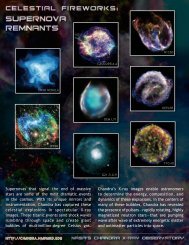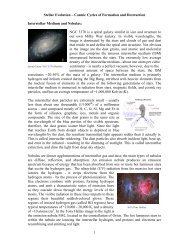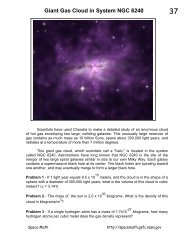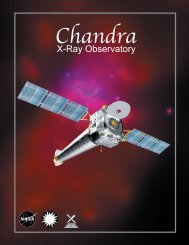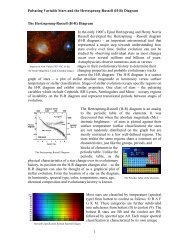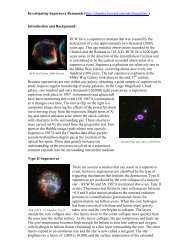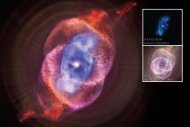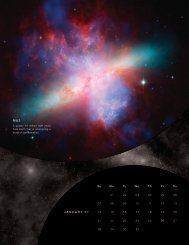CHEMISTRY UNIVERSE - Chandra X-ray Observatory
CHEMISTRY UNIVERSE - Chandra X-ray Observatory
CHEMISTRY UNIVERSE - Chandra X-ray Observatory
You also want an ePaper? Increase the reach of your titles
YUMPU automatically turns print PDFs into web optimized ePapers that Google loves.
CASSIOpeIA A<br />
ANTeNNAe<br />
SAGITTArIUS A*<br />
M82<br />
Illustration<br />
SCUlpTOr-WAll<br />
For more information go to:<br />
http://chandra.si.edu<br />
<strong>Chandra</strong> images and spectra of individual supernova remnants reveal clouds of gas<br />
rich in elements such as oxygen, silicon, sulfur, calcium and iron, and track the speed<br />
at which these elements have been ejected in the explosion. The <strong>Chandra</strong> image of<br />
the Cas A supernova remnant shows iron rich ejecta outside silicon-rich ejecta, thus<br />
indicating that turbulent mixing and an aspherical explosion turned much of the original<br />
star inside out. Observations of Doppler-shifted emission lines for Cas A and other supernova<br />
remnants are providing three-dimensional information on the distribution and<br />
velocity of the supernova ejecta which will help to constrain models for the explosion.<br />
On a larger scale, observations of galaxies undergoing bursts of star formation show<br />
that vast regions of these galaxies have been enriched by the combined action of<br />
thousands of supernovas. The Antennae galaxy system was produced by the collision<br />
of two galaxies. This collision created bursts of star formation and, few million years<br />
later, thousands of supernovas which heated and enriched clouds of gas thousands<br />
of light years in extent.<br />
An unexpected agent for distributing heavy elements throughout a galaxy is a supermassive<br />
black hole in the center of a galaxy (for example, Sagittarius A*). Gas spiraling<br />
toward black holes can that become overheated and produce a wind of gas that<br />
flows away from the black hole, or it can create an intense electromagnetic field that<br />
drives enriched material into the outer reaches of the galaxy and beyond.<br />
On a still larger scale, oxygen has been detected in intergalactic filaments millions of<br />
light years in length. This oxygen was likely produced more than ten billion years ago,<br />
in some of the first supernovas to occur in the history of the Universe. If the rate of<br />
supernovas gets so high that the combined effects of many supernova shock waves<br />
drives a galactic-scale wind that blows the gas out of the galaxy. A prime example is<br />
the galaxy M82.<br />
Galactic winds such as the one in M82 are rare today, but they were common billions<br />
of years ago when galaxies were very young and stars were forming rapidly because<br />
of frequent collisions between galaxies. <strong>Chandra</strong> showed that the Sculptor Wall, a<br />
collection of gas and galaxies that stretches across tens of millions of light years,<br />
contains a vast reservoir of gas enriched in oxygen from galactic winds. The Sculptor<br />
Wall is thought to be part of an enormous web of hot, diffuse gas containing as much<br />
as half of all the ordinary matter in the Universe.<br />
NASA’s Marshall Space Flight Center, Huntsville, Ala., manages the <strong>Chandra</strong> program for the<br />
agency’s Science Mission Directorate. The Smithsonian Astrophysical <strong>Observatory</strong> controls<br />
science and flight operations from the <strong>Chandra</strong> X-<strong>ray</strong> Center in Cambridge, Mass.<br />
In this version of the periodic<br />
table, the average<br />
relative abundance by<br />
mass of the various elements<br />
in the Universe<br />
is indicated by the number<br />
in the square, which<br />
gives the abundance in<br />
parts per 10,000. The<br />
sum of the abundances<br />
of all the elements<br />
without numbers is<br />
less than one part per<br />
10,000. The abundances<br />
give important clues<br />
to the nuclear reactions<br />
and cosmic settings required<br />
to produce the<br />
various elements.<br />
NASA’s <strong>Chandra</strong> X-<strong>ray</strong> <strong>Observatory</strong> presents<br />
Chemistry<br />
and the Universe<br />
7,500<br />
H 2,300<br />
He<br />
0.2<br />
Na<br />
6<br />
Mg<br />
0.7<br />
Ca<br />
11<br />
Fe<br />
0.6<br />
Ni<br />
0.5<br />
Al<br />
50<br />
C<br />
7<br />
Si<br />
10<br />
N 100<br />
O<br />
The Periodic Table for asTronomy<br />
5<br />
S<br />
13<br />
Ne<br />
2<br />
Ar<br />
This pie chart illustrates the average<br />
abundance by mass of the various<br />
elements in the Universe (called<br />
the cosmic abundances) in parts<br />
per 10,000. The large abundance<br />
of hydrogen and helium and the<br />
small abundances of all the rest of<br />
the elements (about 2% of the total),<br />
as well as evidence from other<br />
observations, indicate that the Universe<br />
was once composed on just<br />
one element, hydrogen, and that<br />
the nuclear fusion reactions that<br />
produce the heavier elements have<br />
proceeded very slowly over the 13.7<br />
billion year history of the Universe.<br />
This is a good thing, since otherwise<br />
the Sun would have likely burned<br />
out long ago.<br />
H - Hydrogen: 7,500<br />
He - Helium: 2,300<br />
O - Oxygen: 100<br />
C - Carbon: 50<br />
Ne - Neon: 13<br />
Fe - Iron: 11<br />
N - Nitrogen: 10<br />
Si - Silicon: 7<br />
Mg - Magnesium: 6<br />
S - Sulfur: 5<br />
Ar - Argon: 2<br />
Ca - Calcium: 0.7<br />
Ni - Nickel: 0.6<br />
Al - Aluminium: 0.5<br />
Na - Sodium: 0.2
The periodic Table<br />
of elements is an organized<br />
way of displaying<br />
information<br />
about the approximately<br />
100 chemical<br />
building blocks of the<br />
Universe. The number<br />
that is above<br />
the letter in each box<br />
is the atomic number<br />
for that element. It<br />
represents the number<br />
of protons in one<br />
atom of the element.<br />
1<br />
H<br />
3<br />
Li<br />
11<br />
Na<br />
19<br />
K<br />
37<br />
Rb<br />
55<br />
Cs<br />
87<br />
Fr<br />
4<br />
Be<br />
12<br />
Mg<br />
20<br />
Ca<br />
38<br />
Sr<br />
56<br />
Ba<br />
88<br />
Ra<br />
21<br />
Sc<br />
39<br />
Y<br />
57<br />
La<br />
89<br />
Ac<br />
22<br />
Ti<br />
40<br />
Zr<br />
72<br />
Hf<br />
23<br />
V<br />
41<br />
Nb<br />
73<br />
Ta<br />
105<br />
Db<br />
58<br />
Ce<br />
90<br />
Th<br />
24<br />
Cr<br />
42<br />
Mo<br />
74<br />
W<br />
106<br />
Sg<br />
59<br />
Pr<br />
91<br />
Pa<br />
25<br />
Mn<br />
43<br />
Tc<br />
75<br />
Re<br />
107<br />
Bh<br />
60<br />
Nd<br />
92<br />
U<br />
26<br />
Fe<br />
44<br />
Ru<br />
76<br />
Os<br />
108<br />
Hs<br />
61<br />
Pm<br />
93<br />
Np<br />
The Periodic Table<br />
104<br />
Rf<br />
27<br />
Co<br />
45<br />
Rh<br />
77<br />
Ir<br />
109<br />
Mt<br />
62<br />
Sm<br />
94<br />
Pu<br />
28<br />
Ni<br />
46<br />
Pd<br />
78<br />
Pt<br />
110<br />
Ds<br />
63<br />
Eu<br />
95<br />
Am<br />
29<br />
Cu<br />
47<br />
Ag<br />
79<br />
Au<br />
111<br />
Rg<br />
64<br />
Gd<br />
96<br />
Cm<br />
30<br />
Zn<br />
48<br />
Cd<br />
80<br />
Hg<br />
112<br />
Cn<br />
65<br />
Tb<br />
97<br />
Bk<br />
5<br />
B<br />
13<br />
Al<br />
31<br />
Ga<br />
49<br />
In<br />
81<br />
Tl<br />
66<br />
Dy<br />
98<br />
Cf<br />
6<br />
C<br />
14<br />
Si<br />
32<br />
Ge<br />
50<br />
Sn<br />
82<br />
Pb<br />
67<br />
Ho<br />
99<br />
Es<br />
7<br />
N<br />
15<br />
P<br />
33<br />
As<br />
51<br />
Sb<br />
83<br />
Bi<br />
68<br />
Er<br />
100<br />
Fm<br />
8<br />
O<br />
16<br />
S<br />
34<br />
Se<br />
52<br />
Te<br />
84<br />
Po<br />
69<br />
Tm<br />
101<br />
Md<br />
9<br />
F<br />
17<br />
Cl<br />
35<br />
Br<br />
53<br />
I<br />
85<br />
At<br />
70<br />
Yb<br />
102<br />
No<br />
2<br />
He<br />
10<br />
Ne<br />
18<br />
Ar<br />
36<br />
Kr<br />
54<br />
Xe<br />
86<br />
Rn<br />
114 116 118<br />
71<br />
Lu<br />
103<br />
Lr<br />
Chemistry, the study of the intricate dances and<br />
bondings of low-energy electrons to form the molecules<br />
that make up the world we live in, may seem far<br />
removed from the thermonuclear heat in the interiors<br />
of stars and the awesome power of supernovas. Yet,<br />
there is a fundamental connection between them.<br />
To illustrate this connection, the familiar periodic table<br />
of elements—found in virtually every chemistry<br />
class—has been adapted to show how astronomers<br />
see the chemical Universe. What leaps out of this<br />
table is that the simplest elements, hydrogen and helium,<br />
are far and away the most abundant.<br />
The Universe started out with baryonic matter in its<br />
simplest form, hydrogen. In just the first 20 minutes<br />
or so after the Big Bang, about 25% of the hydrogen<br />
was converted to helium. In essence, the chemical<br />
history of the Universe can be divided into two mainphases:<br />
one lasting 20 minutes, and the rest lasting<br />
for 13.7 billion years and counting.<br />
After that initial one third of an hour, the expanding<br />
Universe cooled below the point where nuclear fusion<br />
could operate. This meant that no evolution of<br />
matter could occur again until stars were formed a<br />
few million years later. Then the buildup of elements<br />
heavier than helium could begin.<br />
Stars evolve through a sequence of stages in which<br />
nuclear fusion reactions in their central regions build<br />
up helium and other elements (see illustration, far<br />
right).The energy supplied by fusion reactions creates<br />
the pressure needed to hold the star up against<br />
gravity. Winds of gas escaping from stars distribute<br />
some of this processed matter into space in a rela-<br />
tively gentle manner and supernovas do it violently.<br />
As the enrichment of the interstellar and intergalactic<br />
gas has proceeded over vast stretches of space and<br />
time, the chemistry of the cosmos has become richer,<br />
too. Subsequent generations of stars have formed<br />
from interstellar gas enriched in heavy elements. Our<br />
Sun, Solar System, and indeed the existence of life<br />
on earth are direct results of this long chain of stellar<br />
birth, death, and rebirth. In this way, the evolution<br />
of matter, stars and galaxies are all inextricably tied<br />
together and so too are astronomy and chemistry.<br />
One of the principal scientific accomplishments of<br />
the <strong>Chandra</strong> X-<strong>ray</strong> <strong>Observatory</strong> has been to help<br />
unravel how the chemical enrichment by stellar<br />
winds and supernovas works on a galactic and intergalactic<br />
scale.<br />
The chemical composition of the Universe has been constantly<br />
changing throughout its 13.7 billion year history.<br />
Illustration: NASA/CXC/M.Weiss<br />
pre-SUperNOvA STAr IllUSTrATION




